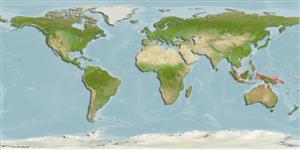Ελασμοβράγχιοι (καρχαρίες και σαλάχια) (sharks and rays) >
Myliobatiformes (Stingrays) >
Dasyatidae (Stingrays) > Urogymninae
Etymology: Pateobatis: Combination of Latin 'pateo' for 'lie open, be exposed' and 'batis' for skate, ray or flatfish; referring to the eclectic nature of members of this group.; hortlei: Named for Kent Hortle..
More on authors: Last, Manjaji-Matsumoto & Kailola.
Environment: milieu / climate zone / depth range / distribution range
Οικολογία
Θαλασσινό(ά); Υφάλμυρο βενθικό(ς); εύρος βάθους 2 - 7 m (Ref. 58025). Tropical
Western Pacific: eastern Indonesia (Irian Jaya), Papua New Guinea and northern Australia.
Μέγεθος / Βάρος / Age
Maturity: Lm ? range ? - ? cm
Max length : 70.7 cm WD αρσενικό/απροσδιόριστο; (Ref. 58025); 65.4 cm WD (female)
Short description
Μορφολογία | Μορφομετρία
Distinguished by the following combination of characters: subcircular disc, very angular anteriorly, length 1.1 times DW; pectoral-fin apices broadly rounded; snout extremely elongate, 11-18 times orbit diameter, 96-99° angle; snout to maximum disc width 52-58% of DW; orbit very small, diameter 0.4-0.5 of spiracle length, 3.8-6.3 times in interorbital distance; mouth not greatly protrusible; prepelvic process not expanded; 1-3 enlarged, flattened, pearl-shaped mid-scapular denticles; denticles of main band in two main sizes in adults, crowns plate-like to heart-shaped; dorsal disc uniformly yellowish, brownish, or greyish; ventral surface of adults usually canary yellow in fresh material, often black around oronasal region and gill slits; pectoral fin radials 135-143; pelvic-fin radials 22-28; total vertebral centra 99-108 (Ref. 58025).
Demersal inshore; commonly found over shallow intertidal mud flats and in estuaries in only several metres depth. Viviparous, with histotrophy. Presumably feeds on crustaceans, molluscs and small fishes. Caught regularly, but usually avoided, by beach seine fisheries operating in intertidal habitats. Possibly adversely affected by mangrove loss. Utilized for its meat, and possibly also for its skin and cartilage. (Ref.58048).
Life cycle and mating behavior
Γεννητική Ωρίμανση | Αναπαραγωγή | Γεννοβολία | Αβγά | Γονιμότητα | Προνύμφες
Last, P.R., M. Manjaji-Matsumoto and P.J. Kailola, 2006. Himantura hortlei n. sp., a new species of whipray (Myliobatiformes: Dasyatidae) from Irian Jaya, Indonesia. Zootaxa 1239:19-34. (Ref. 58025)
IUCN Red List Status (Ref. 130435)
Threat to humans
Harmless
Human uses
Περισσότερες πληροφορίες
Κοινά ονόματαΣυνώνυμαΜεταβολισμόςΘηρευτέςΟικοτοξικολογίαΑναπαραγωγήΓεννητική ΩρίμανσηΓεννοβολίαΣυναθροίσεις γεννοβολίαςΓονιμότηταΑβγάEgg development
Age/SizeΑύξησηLength-weightLength-lengthLength-frequenciesΜορφομετρίαΜορφολογίαΠρονύμφεςΔυναμική προνυμφώνΣτρατολόγησηΑφθονίαBRUVS
ΑναφορέςΥδατοκαλλιέργειεςΠροφίλ υδατοκαλλιέργειαςΣτελέχοιΓενετικήElectrophoresesΚληρονομικότηταΑσθένειεςΜεταποίησηNutrientsMass conversion
ΣυνεργάτεςΦωτογραφίεςStamps, Coins Misc.ΉχοιΣιγκουατέραΤαχύτηταΚολυμβητικός ΤύποςΕπιφάνεια βραγχίωνOtolithsΕγκέφαλοιΌραση
Εργαλεία
Special reports
Download XML
Διαδικτυακές πηγές
Estimates based on models
Preferred temperature (Ref.
123201): 27.9 - 29.2, mean 28.8 °C (based on 264 cells).
Phylogenetic diversity index (Ref.
82804): PD
50 = 0.5312 [Uniqueness, from 0.5 = low to 2.0 = high].
Bayesian length-weight: a=0.00832 (0.00366 - 0.01891), b=3.10 (2.90 - 3.30), in cm total length, based on LWR estimates for this (Sub)family-body shape (Ref.
93245).
Τροφικό Επίπεδο (Ref.
69278): 3.5 ±0.5 se; based on size and trophs of closest relatives
Fishing Vulnerability (Ref.
59153): Very high vulnerability (90 of 100).
